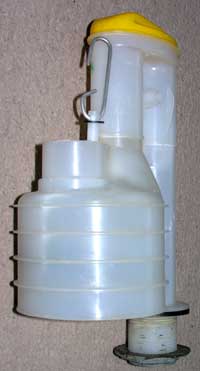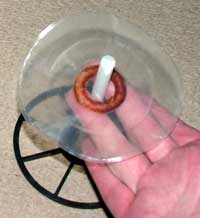Lavatory cisterns
replacing a syphon diaphragm
About the only part which wears out in a syphon type cistern is the diaphragm or flap which lifts the water into the syphon to start the water flowing.
The diaphragm becomes worn or torn overtime so it cannot lift enough water quicker enough into the syphon - the water just passes back through the diaphragm.
The fault may develop suddenly or, more generally, it will get worse over a period of time.
One problem with a worm diaphragm is that it cannot be seen, it's tuck away inside the syphon.
The only way to see the diaphragm is to dismantle the syphon from the cistern. So before starting on this, check the water level inside the cistern, if the water is low, it can give similar symptoms as a damaged diaphragm - the water should be about 12mm (½ inch) under the outlet to the overflow.
Replacement diaphragms are available for most siphons from DIY or hardware stores, diaphragms do vary in shape and size depending on the shape and size of the syphon.
As most diaphragms are just flexible plastic, an oversized one could be cut to size once the original syphon has been dismantled.
Having decided that a worm diaphragm is the probably cause of the problem, and obtained a suitable replacement, the procedure is fairly straight forward although it does vary slightly depending on whether the lavatory suit has a separate cistern with a connecting pipe or uses a close coupled arrangement.
High/Low cistern with a connecting pipe
- Turn off the water supply to the cistern and operate the flush to empty as much water as possible. Where the cistern is fed from a water tank and there is no shut-off valve in the pipework, it may be possible to isolate the water supply by tying up the ball-valve arm to a piece of wood laid across the top of the cistern to temporarily shut off the water - this would avoid having to drain the whole tankful of water.
- To minimise mess, use a sponge(or similar) to remove the remaining water laying in the bottom of the cistern.
- Locate within the cistern, the link connecting the vertical rod of the syphon and the handle/chain rocker - disconnect this link (it's usually easier to remove it from the handle/chain rocker leaving it attached to the vertical rod).
- From under the cistern, disconnect the fitting holding the down pipe to the syphon/cistern, the down pipe can be left in place.
- Under the cistern, release the very large nut which secures the syphon to the bottom of the cistern; as the nut is rotated, the body of the syphon within the cistern will need to be held to avoid it also rotating.
- Once the large nut has been removed from the thread,lift the syphon out of the cistern taking care that it clears the ball valve mechanism etc -some cisterns have very little space,removing the float from the ball valve arm may make it easier. Take the syphon to a work area where it can be dismantled.


- With the complete syphon on a work bench or table:
- Remove the lifting link from the top of the vertical rod - this may require the link to be opened up by bending it.
- Remove any washer which are fitted on the rod between the link and the body of the syphon.
- Support the syphon and allow the rod to drop through; the perforated disc at the bottom of the rod will drop out of the bottom of the syphon reservoir. The condition of the diaphragm can now be seen for the first time.
- Note the position of any washers and weights holding the diaphragm onto the perforated disc and lift these off of the vertical rod.
- Lift the old diaphragm off of the perforated disc.

- Assemble the new diaphragm over the rood and make sure that it covers the perforated disc completely without projecting beyond the edge.
- Reassemble the washers/weights on top of the diaphragm keeping everything in their original positions.
- Finally, fit the perforated disc assembly in to the syphon reservoir with the rod through the hole in the top of it.
- Fit any washer which were previously removed and then fit the link - if necessary, bend the link to prevent it coming off of the rod.
- Remove any old plumbers jointing compound from the syphon and both inside and outside of the cistern.
- Fit the syphon back through the hole in the bottom of the cistern with the large rubber washer between the syphon and the inside of the cistern - use a generous quantity of plumbers jointing compound on the joint. Fit the large nut on to the bottom of the syphon under the cistern - rotate the syphon within the cistern as necessary to allow for the vertical movement of the ball-valve arm before the large nut is fully tightened.
- Refit the float to the valve arm if it had previously been removed.
- Refit the lifting link between the top of the vertical rod and the cistern handle or chain rocker.
- Under the cistern, reconnect the down pipe to the bottom of the syphon and tighten the joint.
- Reconnect the water supply to the cistern (or release the ball-valve arm ) and refill the cistern.
- When the cistern has refilled, operate the flush to check all is well.
Close coupled cistern/pan arrangement:
The only difference to the above procedure, is that the cistern must be disconnect from the water feed and overflow pipes and then removed from the pan before the syphon can be removed.
- Turn off the water supply to the cistern, if it is fed directly from a tank without a shut-off valve, turn off the water feed to the tank and then drain it, if there are taps on the same feed (which is probable), open these to save repeated flushing. If you have to drain a water tank, it may an appropriate time to fit a shut-off valve between the tank and the cistern so that it can be isolated in future.
- Once the water supply has been isolated or drained, flush the cistern and disconnect the water supply coupled to the ball-valve.
- Disconnect the overflow pipe from the cistern.
- Usually, the cistern is fixed to the wall and also to the pan, release the fixings to the pan first and then the fixings to the wall.
- Carefully lift the cistern off of the pan and empty the water in the bottom of the cistern by tipping it in to the pan.
- Lay the cistern on its back and remove the syphon - the syphon can now be dismantled and the diaphragm replaced as described above.
- After the diaphragm has been replaced and refitted to the cistern, the cistern can be refitted to the pan, ensure that the large 'doughnut' washer (if originally fitted) is positioned between the underside of the cistern and the pan around the syphon outlet.
- Before re fixing the cistern to the pan and wall, check that the overflow and water inlet pipes are in line with the fittings on the cistern. Then fix the cistern to the wall and then to the pan (do not over tighten the fixings to the pan).
- Reconnect the overflow and water inlet pipes to the cistern.
- Turn on the water supply to the cistern and allow it to fill up.
- When the cistern has refilled, operate the flush to check all is well.
